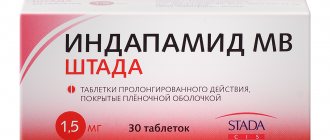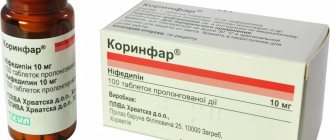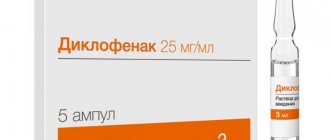Tegretol CR, 50 pcs., 200 mg, extended-release, film-coated tablets
The drug should be taken only under medical supervision.
Patients with mixed forms of epileptic seizures, including absence and myoclonic seizures
The drug is usually ineffective for absence seizures (petit mal) and myoclonic seizures. In patients with mixed forms of epileptic seizures, the drug should be used with caution and only with regular medical supervision (due to a possible increase in seizures). If attacks intensify, Tegretol® CR should be discontinued.
Decreased platelet and white blood cell counts
During use of the drug with varying frequency, a transient or persistent decrease in the number of platelets or leukocytes is observed. However, in most cases these phenomena are transient and usually do not predict the onset of aplastic anemia or agranulocytosis.
Before starting treatment, as well as periodically during treatment, clinical blood tests should be performed, including counting the number of platelets and, possibly, reticulocytes, as well as determining the concentration of iron in the blood serum.
Patients should be informed of early signs of toxicity associated with possible hematological disorders, as well as skin and liver symptoms. The patient is informed of the need to immediately consult a doctor in case of adverse reactions such as fever, sore throat, rash, mouth ulcers, unexplained hemorrhages, hemorrhages in the form of petechiae or purpura.
In cases where a low white blood cell or platelet count (or a trend towards a decrease) is noted during treatment, the patient's condition and complete clinical blood count should be closely monitored. If signs of significant bone marrow suppression are detected, Tegretol® CR should be discontinued.
Dermatological reactions
When using the drug Tegretol® CR, severe dermatological reactions, including Stevens-Johnson syndrome and toxic epidermal necrolysis (Lyell's syndrome), were very rarely observed.
The drug Tegretol® CR should be immediately discontinued and alternative therapy should be selected if signs and symptoms are observed that presumably indicate the development of severe dermatological reactions - for example, Stevens-Johnson syndrome or Lyell's syndrome. If severe (in some cases life-threatening) skin reactions develop, the patient should be hospitalized in a hospital. In most cases, Stevens-Johnson syndrome and Lyell's syndrome developed in the first months of drug therapy. These reactions occurred in approximately 1-6 cases per 10,000 people taking the drug for the first time in countries with a predominantly Caucasian population.
Data from a retrospective analysis of Japanese and Northern European patients demonstrated an association between severe skin lesions (Stevens-Johnson syndrome, Lyell's syndrome, drug rash with eosinophilia and systemic manifestations, acute generalized exanthematous pustulosis and macular nodular rash) in carriers of the HLA-A allele *3101 human leukocyte antigen (HLA) gene and the use of carbamazepine.
The frequency of the HLA-A*3101 allele of the human leukocyte antigen (E1LA) gene may differ among different ethnic groups: about 2-5% in the European population, about 10% in the Japanese. The allele frequency is less than 5% in the populations of Australia, Asia, Africa and North America, with exceptions ranging from 5% to 12%. A frequency of more than 15% has been found in some ethnic groups of South America (Argentina and Brazil), indigenous people of North America (Navajo and Sioux tribes, Sanora Seri in Mexico), South India (Tamil Nadu), and 10-15% among other indigenous people these regions.
When using carbamazepine in possible carriers of the HLA-A*3101 allele (for example, patients of Japanese nationality, Caucasians, Native Americans, Latin Americans, people of southern India and Arabs), it is recommended to carry out genotyping for this allele. The drug should be used in carriers of this allele only if the benefits of therapy outweigh the possible risks.
For patients already receiving therapy with Tegretol® CR, genotyping for this allele is not recommended, since severe skin reactions in most cases were observed in the first months of drug use (regardless of the presence of HLA-A*3101).
According to a retrospective analysis of the use of the drug in patients of Chinese and Thai nationality, there is a correlation between the incidence of Stevens-Johnson syndrome and Lyell syndrome and the presence of the HLA-B*1502 allele of the human leukocyte antigen (HLA) gene in the patient’s genome. The frequency of occurrence of this allele in patients of Chinese nationality is 2-12%, in Thai patients it is about 8%.
When carbamazepine was used in patients in the countries of the Asian region (Taiwan, Malaysia, the Philippines), where there is a high prevalence of the HLA-B* 1502 allele, an increase in the incidence of Stevens-Johnson syndrome was detected (from “very rare” to “rare”). The frequency of distribution of the HLA-B* 1502 allele is: in the Philippines and among some groups of the population of Malaysia - more than 15%. The prevalence of the HLA-BM502 allele in Korea and India is 2% and 6%, respectively.
The prevalence of this allele in people of Caucasian, Negroid races, Latin Americans, Indians and Japanese is insignificant (<1%). These allele frequencies represent the percentage of chromosomes in specific populations that carry the allele. This means that the percentage of patients carrying a copy of the allele on at least one of their two chromosomes is almost twice the frequency of the allele. Thus, the percentage of patients who may be at risk is almost twice the allele frequency.
When using carbamazepine in possible carriers of the HLA-B*1502 allele, it is recommended to carry out genotyping for this allele.
The drug should be used in carriers of this allele only if the benefits of therapy outweigh the possible risks. It is not recommended to carry out genotyping in representatives of nationalities in whose population the frequency of occurrence of the specified allele is low.
For patients already receiving therapy with Tegretol® CR, genotyping for this allele is not recommended, since severe skin reactions in most cases were observed in the first months of drug use (regardless of the presence of HLA-B* 1502.
Identification of patients with the presence of the HLA-B* 1502 allele and avoidance of carbamazepine use in such patients has been shown to reduce the incidence of carbamazepine-induced Stevens-Johnson syndrome or Lyell's syndrome.
However, the results of genotyping should not affect the degree of monitoring of the patient's condition and the doctor's alertness regarding severe skin reactions. The development of severe skin lesions is possible in patients negative for these alleles. Also, in many cases, in patients positive for the HLA-B* 1502 or HLA-A*3101 alleles, the development of severe skin syndromes was not observed when using the drug Tegretol® CR.
The influence of other factors, such as the dose of anticonvulsants, patient compliance, concomitant therapy with other drugs, concomitant diseases, or the level of control of dermatological reactions, on the incidence and prevalence of severe skin reactions has not been established.
Mild skin reactions, for example, isolated macular or maculopapular exanthema, are in most cases transient and mild, usually disappearing within a few days or weeks with continued treatment or after reducing the dose of the drug. However, since differential diagnosis between early manifestations of severe skin reactions and mild, transient skin rashes can be difficult, if any skin reactions develop, the patient should be under medical supervision (with a view to timely discontinuation of drug therapy if the patient's condition worsens).
There is a relationship between the presence of the HLA-A*3101 allele in the genome and the development of less severe skin reactions (such as hypersensitivity syndrome to anticonvulsants or mild maculopapular exanthema); such a relationship has not been established for the HLA-B*1502 allele.
Hypersensitivity reactions
With the development of hypersensitivity to the drug Tegretol® CR, patients may experience various reactions, including drug rash with eosinophilia and systemic manifestations, delayed multiorgan manifestations of hypersensitivity with the development of fever, rash, vasculitis, lymphadenopathy, pseudolymphoma, arthralgia, leukopenia, eosinophilia, hepatosplenomegaly, changes in parameters liver function and bile duct destruction syndrome with a decrease in their number, which can occur in any combination. Damage to other internal organs (including lungs, kidneys, pancreas, myocardium, colon) is also possible.
In case of development of manifestations and symptoms of hypersensitivity to the drug Tegretol® CR, the drug should be discontinued immediately.
Patients with known hypersensitivity to carbamazepine should be informed of the possibility of developing hypersensitivity reactions to oxcarbazepine in 25-30% of cases. Cross-hypersensitivity reactions also occur between carbamazepine and phenytoin.
Hyponatremia
The development of hyponatremia is associated with the use of carbamazepine. In patients with pre-existing renal impairment associated with low serum sodium or in patients receiving concomitant drugs that reduce sodium (eg, diuretics, drugs that affect antidiuretic hormone secretion), serum sodium should be determined before initiation of carbamazepine therapy. Thereafter, sodium levels should be determined approximately two weeks later and then monthly for the first three months of therapy, or as clinically necessary. These risk factors are especially common in older patients. If hyponatremia occurs, water restriction is an important criterion to determine the condition when clinically indicated.
Hypothyroidism
Carbamazepine may reduce serum concentrations of thyroid hormones through enzyme induction, requiring an increase in the dose of drugs used for replacement therapy in patients with hypothyroidism. In this category of patients, monitoring of thyroid function is necessary to select the dose of replacement therapy drugs.
Liver dysfunction
Before using the drug Tegretol® CR and during treatment, it is necessary to conduct a liver function test, especially in patients with a history of liver disease, as well as in elderly patients. If pre-existing liver dysfunction worsens or active liver disease develops, Tegretol® should be discontinued immediately.
Renal dysfunction
Before starting treatment with the drug and periodically during therapy, it is recommended to conduct a general urine test and determine the concentration of urea in the blood.
M-anticholinergic activity
The drug has weak m-anticholinergic activity. Therefore, when using the drug in patients with increased intraocular pressure and urinary retention, constant monitoring of this indicator is necessary.
Mental disorders
Since the use of the drug may exacerbate latent mental disorders, elderly patients should be monitored to identify symptoms such as confusion and psychomotor agitation.
Suicidal behavior or intentions
Cases of suicidal behavior or intent have been reported in patients receiving anticonvulsants for a number of indications. The results of a meta-analysis of randomized placebo-controlled trials showed a small increase in the risk of developing suicidal behavior in patients receiving anticonvulsants. The mechanism of increased suicidal behavior in this category of patients has not been established. Therefore, careful monitoring of symptoms of suicidal behavior and intentions and decisions on appropriate treatment are necessary. Patients (and their caregivers) should be strongly advised to seek help from a physician if they experience symptoms of suicidal behavior or intentions.
Endocrinological disorders
The drug may reduce the effectiveness of medications containing estrogens and/or progesterone, so women of childbearing age should use alternative methods of birth control during treatment with the drug.
To date, there have been very rare reports of disturbances in male fertility and/or disturbances in spermatogenesis.
Determination of carbamazepine concentration in blood plasma
Although the relationship between drug dose, carbamazepine plasma concentration, clinical efficacy or tolerability is very small, regular determination of carbamazepine concentration may be advisable in the following situations: when there is a sharp increase in the frequency of attacks, in order to check whether the patient is taking the drug properly; during pregnancy; when treating children or adolescents; if there is a suspicion of impaired absorption of carbamazepine; if toxic reactions are suspected if the patient is taking several medications.
Description of the release form. Features of the composition
Many people are prescribed the drug Tegretol. Instructions for use, pharmacological properties, indications, possible complications - this is important information. But first, it’s worth studying the general information.
The drug is available in the form of tablets, packaged in blisters of 10 pieces. The main active ingredient is carbamazepine - one tablet can contain 200 or 400 mg of the substance. In addition, the drug contains magnesium stearate, colloidal, anhydrous silicon dioxide, carmellose sodium and microcrystalline cellulose.
At the pharmacy you can buy the drug "Tegretol" in syrup form. As before, the main active ingredient is carbamazepine (100 mg of the substance in 5 ml of syrup). The production also uses components such as liquid sorbitol, macrogol stearate, hydroxyethylcellulose, propylene glycol, sodium saccharinate, purified water, sorbic acid, methyl parahydroxybenzoate and flavorings. The syrup is packaged in dark glass bottles of 100 ml.
Pharmacokinetic information
After administration, the drug is almost completely absorbed by the walls of the digestive tract. The maximum concentration of the main component is observed approximately 12 hours after consuming the tablet. If we are talking about syrup, then absorption occurs faster - the maximum concentration is reached after two hours.
According to the results of clinical trials, food intake does not in any way affect the absorption and assimilation of the drug.
Carbamazepine is approximately 70-80% bound to plasma proteins. Approximately 20-30% of the active substance penetrates into saliva and cerebrospinal fluid unchanged. This component of the drug penetrates the placental barrier and is excreted in breast milk.
Carbamazepine is metabolized in liver cells, forming a transdiol derivative, as well as its conjugate with glucuronic acid. The half-life is 36 hours for a single dose. If the patient takes the drug constantly, then this indicator is 16-24 hours.
The main part of carbamazepine and its metabolites is excreted by the kidneys. About 25-30% of these substances leave the body along with feces.
In some cases, doctors prescribe patients to take Tegretol CR tablets. Reviews, as well as the results of laboratory tests, indicate that this form of the drug has a longer effect, which in some cases is simply necessary.
How does the drug affect the body?
Carbamazepine is a dibenzoazepine derivative. This substance is the main component of the drug Tegretol. Reviews indicate that it has pronounced psychotropic, neurotropic and antiepileptic properties.
Unfortunately, the exact mechanisms of action of carbamazepine remain unknown to date. It is known that this substance is capable of acting on the membranes of overexcited neurons, stabilizing them. This reduces the intensity of synaptic transmission of impulses. It is believed that the drug acts on the sodium channels of neurons, thereby preventing the re-occurrence of sodium-dependent potentials in depolyarized neurons.
The drug copes well with epileptic seizures. It also eliminates symptoms of depressive conditions, helps cope with increased anxiety, irritability, and attacks of aggression. During clinical trials, it was also found that taking the medicine has a positive effect on a person’s ability to remember information and concentrate.
If we are talking about secondary or idiopathic neuralgia, then the drug helps to reduce the symptoms of a paroxysmal pain attack or prevent its occurrence. During alcohol withdrawal, this substance increases the threshold of convulsive readiness, thereby helping to cope with tremors, increased excitability, gait disturbances and other symptoms.
Patients with diabetes insipidus note a decrease in diuresis and the disappearance of the feeling of constant thirst during therapy.
The drug also inhibits the metabolism of norepinephrine and dopamine, which helps to cope with manic states against the background of various mental disorders.
It is worth noting that this remedy can be used either alone (monotherapy) or in combination with other drugs.
Medicine "Tegretol": instructions for use
Of course, in no case should such means be used arbitrarily. If we are talking about tablets, then they are taken regardless of food intake, washed down with a small amount of water. After a few days, quite a few of the patients are transferred to taking Tegretol CR tablets, which provide a prolonged effect.
As for the syrup, it must be shaken before taking. This form of medication is prescribed if, for one reason or another, the patient cannot swallow the tablet. For example, doctors often recommend taking Tegretol syrup for children. Reviews indicate that therapy should be started with a minimum dose, gradually increasing it.
The dosage regimen, of course, depends on the form and stage of development of the disease.
- If we are talking about epilepsy, then adult patients take 100-200 mg of carbamazepine 1-2 times a day. The dose is gradually increased to 400 mg 2-3 times a day. Children under 4 years old take 20-60 mg per day.
- For trigeminal neuralgia, patients first take 200-400 mg per day. Subsequently, the daily dose is increased to 600-800 mg.
- Patients in a state of alcohol withdrawal take 200 mg of carbamazepine three times a day.
- In order to relieve pain associated with the progression of diabetic neuropathy, patients take 400-800 mg per day (to be divided into 2-4 doses).
- For bipolar disorders and manic states, doctors recommend taking 400-600 mg of medication per day (divided into 2-3 doses).
The drug "Tegretol": reviews from doctors and patients
We have already familiarized ourselves with the basic information about this medicine. How effective can therapy with the drug in question be? In fact, the product really helps. The most pronounced effect of Tegretol is for trigeminal neuralgia. Reviews confirm that the drug significantly improves well-being and quickly relieves pain, even after the first dose.
The medicine copes with epileptic seizures and helps maintain the patient’s emotional state in various mental disorders. The drug has not many contraindications, and adverse reactions are recorded relatively rarely. The undoubted advantages of the product include its affordable cost, because most of its analogues are much more expensive.
Of course, you should never use the drug without permission - only a doctor can draw up a competent, effective treatment regimen.
Main indications for therapy
In what cases is it advisable to take the drug "Tegretol" or "Tegretol CR"? Instructions for use indicate that the drug is effective in the following cases:
- some forms of epilepsy;
- acute manic disorders;
- withdrawal syndrome associated with alcohol intake;
- for various forms of bipolar disorder (the drug weakens existing symptoms and prevents the development of certain exacerbations);
- trigeminal neuralgia (lesions can be either associated with the progression of multiple sclerosis or be idiopathic in nature);
- diabetic neuropathies accompanied by severe pain;
- neuralgia of the nerves innervating the glossopharyngeal region (regardless of origin);
- non-insulin-dependent diabetes, the progression of which is accompanied by neurohormonal changes and cerebral disorders.
How can you sit, there are a large number of pathologies for which taking the drug Tegretol is effective. Reviews from doctors indicate that the medicine really helps cope with symptoms. However, in most of the cases described above, complex therapy is required.
List of effective analogues
We have already reviewed the instructions for using Tegretol. Analogs of this drug exist, and their choice on the modern pharmacological market is quite large. The drugs “Karbadak”, “Zagretol”, “Carbapin” have approximately the same properties. Sometimes patients are prescribed medications such as Actinerval, Zeptol, Timonil, Finlepsin. "Tegretol" can be replaced with the drugs "Gen-Karpaz", "Finlepsol", "Umitol".
Of course, it is impossible to use such means without permission under any circumstances, since therapy is associated with a lot of risks and must be carried out under the watchful supervision of a specialist. Only a doctor, after compiling a complete history and thorough diagnosis, can select a substitute.
How much does the drug cost?
Many people are faced with the need to take the drug Tegretol. Instructions, reviews, indications and contraindications - this is interesting information. But for many patients, the cost of the medicine is no less important.
Of course, it is impossible to indicate the exact price, because a lot depends on the manufacturer, place of purchase, dose of the active component and other factors. A package of fifty tablets will cost approximately 350-400 rubles. It is worth noting that many analogues of this drug are much more expensive.





